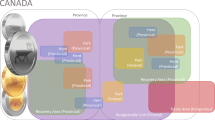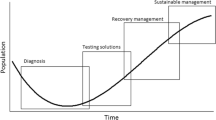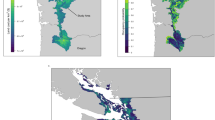Abstract
This paper investigates how different prioritizations of species for conservation can affect both the number of breeding individuals that receive protection and the distribution of conservation attention among different types of habitat. I use as a study example three red lists of the avifauna of Kanton Zürich in northern Switzerland. Species are weighted based on their placement in different red list categories to represent differences in species' relative conservation value. I examine how these weightings affect the number of breeding pairs benefiting from increasing conservation effort. Conservation effort is defined as the number of ranked land parcels that receive conservation attention, be it through habitat enhancement, protection, or other measures. I rank parcels' conservation value based on the number of weighted breeding pairs estimated for each parcel. Not surprisingly, the number of category-1, -2 and -3 breeding pairs that receive benefits varies greatly when different red lists are used. Changes in the relative conservation value of species in different categories influences both the number of breeding pairs and the number of parcels to receive conservation attention. The effect of increasing conservation effort on the number of breeding pairs and the proportion of each landscape type receiving attention also vary when different red lists and relative conservation values are used to determine conservation priorities. Use of the ‘official’ red list published by a governmental body (Bundesamt für Umwelt, Wald und Landschaft, Bern, Switzerland) results in more emphasis on conservation in agricultural landscape than did use of either of the other two lists. The process of prioritization of sites for conservation should evaluate the effects of variation in both the relative conservation value of species and species categorization that may arise due to incomplete data and variation in opinion.
Similar content being viewed by others
References
Avery M, Gibbons DW, Porter R, Tew T, Tucker G and Willimas G (1995) Revising the British red data list for birds: the biological basis of UK conservation priorities. Ibis 137(Suppl 1): 232-239
Berthold P (1976) Methoden der Bestandserfassung in der Ornithologie: Ubersicht und kritische Betrachtung. Journal für Ornithologie 117: 1-69
Böhning-Gaese K and Bauer HG (1996) Changes in species abundance, distribution, and diversity in a central European bird community. Conservation Biology 10: 175-187
Caro TM and O'Doherty G (1999) On the use of surrogate species in conservation biology. Conservation Biology 13: 805-814
Daniels RJR, Hegde M, Joshi NV and Gadgil M (1991) Assigning conservation value: a case study from India. Conservation Biology 5: 464-475
Dunn EH, Hussell DJT and Welsh DA (1999) Priority-setting tool applied to Canada's landbirds based on concern and responsibility for species. Conservation Biology 13: 1404-1415
Heinzel H, Fitter R and Parslow J (1998) Pareys Vogelbuch: alle Vögel Europas, Nordafrikas und des Mittleren Ostens. Parey, Hamburg, Deutschland
IUCN (2000) The 2000 IUCN Red List of Threatened Species. International Union for the Conservation of Nature and Natural Resources, Gland, Switzerland
Jonsson L (1993) Birds of Europe with North Africa and the Middle East. Princeton University Press, Princeton, New Jersey
Kirchhofer A (1997) The assessment of fish vulnerability in Switzerland based on distributional data. Biological Conservation 80: 1-8
Mace GM and Kunin W (1994) Classifying threatened species-means and ends. Philosophical Transactions of the Royal Society of London B 344: 91-97
Mace GM and Lande R (1991) Assessing extinction threats: towards a reevaluation of IUCN threatened species categories. Conservation Biology 5: 148-157
Master LL (1991) Assessing threats and assigning priorities for conservation. Conservation Biology 5: 559-563
Mathew KM (1999) A report on the conservation status of south Indian plants. Biodiversity and Conservation 8: 779-796
Pearman PB (2001) Conservation value of independently evolving units: sacred cow or testable hypothesis? Conservation Biology 15: 780-783
Schiegg K (2000a) Are there saproxylic beetle species characteristic of high dead wood connectivity? Ecography 23: 579-587
Schiegg K (2000b) Effects of dead wood volume and connectivity on saproxylic insect species diversity. Ecography 7: 290-298
Simberloff D (1998) Flagships, umbrellas and keystones: is single species management passé in the landscape era. Conservation Biology 83: 247-257
Wallis-De Vries MF (1995) Large herbivores and the design of large-scale nature reserves in western Europe. Conservation Biology 9: 25-33
Warren MS, Barnett LK, Gibbons DW and Avery MI (1997) Assessing national conservation priorities: an improved red list of British butterflies. Biological Conservation 82: 317-328
Weggler M (1991) Brutvögel im Kanton Zürich. Zürcher Vogelschutz, Zürich, Switzerland
Wilcove DS, Rothstein D, Dubow J, Phillips A and Losos E (1998) Quantifying threats to imperiled species in the United States. Bioscience 48: 607-615
Zbinden N (1989) Beurteilung der Situation der Vogelwelt in der Schweiz in den 1980er Jahren. Schweizerische Vogelwarte, Sempach, Switzerland
Zbinden N, Glutz von Blotzheim UN, Schmid H and Schifferli L (1994) Liste der Schweizer Brutvögel mit Gefährdungsgrad in den einzelnen Regionen. In: Rote Listen der gefährdeten Tierarten in der Schweiz. Bundesamt für Umwelt, Wald und Landschaft, Bern, Switzerland
Author information
Authors and Affiliations
Rights and permissions
About this article
Cite this article
Pearman, P.B. Developing regional conservation priorities using red lists: a hypothetical example from the Swiss lowlands. Biodiversity and Conservation 11, 469–485 (2002). https://doi.org/10.1023/A:1014804516444
Issue Date:
DOI: https://doi.org/10.1023/A:1014804516444




